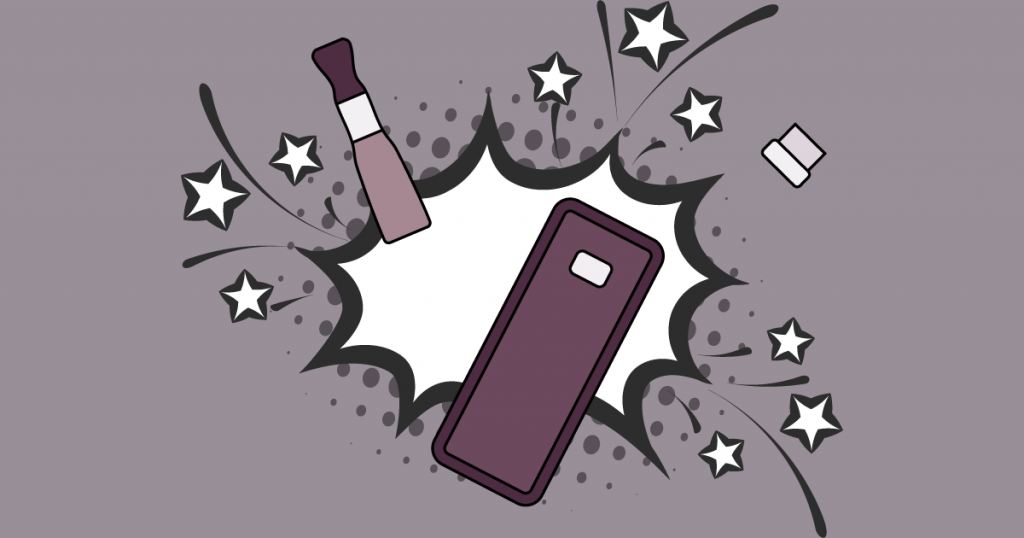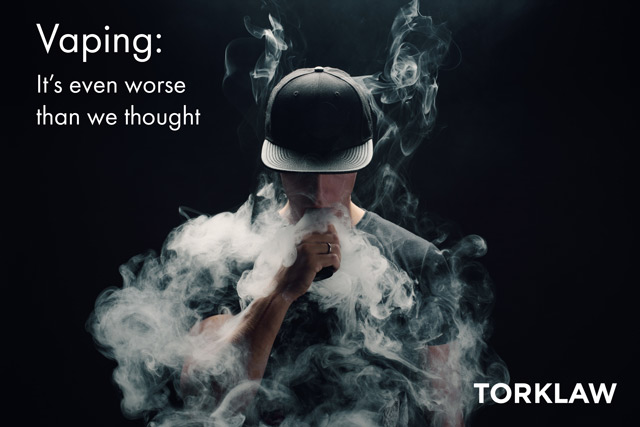A few months ago, we wrote about the dangers of vaping, and concerns about their high levels of nicotine and links to respiratory disease. New evidence shows that e-cigarette use sharply increases a person’s risk of developing chronic lung disease, including all the types listed below.
A recent study tracked lung disease among people who smoke and vape. They started with a group of individuals who did not have any signs of respiratory disease. They tracked the participants’ lung health for three years.
Their findings:
- Risk of lung disease among adults who smoked cigarettes more than doubled.
- Risk of lung disease among adults who used only e-cigarettes increased by 30%.
- The risk for adults who both vape and smoke is more than three times higher.
These figures tell us that while e-cigarettes may be less harmful than regular cigarettes, they are by no means a “safe” option.
The reason vaping is so harmful to the lungs is that in addition to the nicotine, vape cartridges contain other toxic chemicals, as described below.
There is also evidence that toxic materials in the devices themselves can be harmful. Manufacturers may use lead or cadmium-based solder to connect vape and cartridge parts. These toxic metals can transfer into the liquid tank from other parts of the device, and can become part of the aerosol the user inhales. Additionally, the heating elements that change liquid to aerosol can oxidize over time, and the oxidized substances, which can be toxic, can also transfer into the fluid.
There is some evidence that e-cigarettes might help people as an interim step in quitting tobacco. That is, as a short step between smoking conventional cigarettes to eventually giving up nicotine products altogether.
However, too many adults are vaping and smoking regular cigarettes at the same time, or switching to vapes with no plan to stop.
And, many high school students begin their relationship with nicotine by vaping.
Finally, with recreational marijuana becoming legal in more states, many people are using THC products in their vape pens. Many THC cartridges contain harmful substances that further increase the risk of lung injury.
The more we learn, the more it seems that vapes and e-cigarettes are every bit as harmful as regular cigarettes.
Vapes are not safe.
What You Need to Know About Vaping
 Originally published September 30, 2019
Originally published September 30, 2019
Last year, we wrote about the dangers of e-cigarettes, or vapes. As it turns out, exploding vape batteries were the least of the danger. As of September 24, in the United States alone, nine people have died from vaping. The Centers for Disease Control and Prevention reported 530 cases of severe acute respiratory distress syndrome from the use of these devices.
Not surprisingly, there are already 30 individual and class action lawsuits targeting the most popular e-cigarette brand.
Vaping Lawsuits against JUUL Labs, Inc.
These lawsuits include:
- A Chicago teen who was recently hospitalized with severe lung damage. His family is suing both the vape maker, JUUL Labs, Inc. and the store that sold the nicotine-based products to a minor for 18 months.
- A Connecticut man who claims that the JUUL device was so addicting that within two years of starting to use it, he was vaping every 10 minutes. That’s two pods a day, the equivalent of 40 regular cigarettes. He suffered a massive stroke at 19. His permanent, catastrophic injuries, include speech difficulty, paralysis on the left side of his body, and partial vision loss in both eyes.
- A 15-year-old Florida girl who suffered seizures after unintentionally swallowing e-cigarette fluids while using JUUL.
Currently, most states prohibit the sale of tobacco products to people under 18, which means that all the above cases involved illegal tobacco sales to a minor. In Alabama, Alaska and Utah, the minimum age to purchase tobacco is 19. Five states set the minimum age at 21: California, Hawaii, Maine, New Jersey, and Oregon.
What is JUUL?
Currently, JUUL is the most popular manufacturer of electronic nicotine delivery systems. JUUL Labs, Inc. controls about 75% of the U.S. e-cigarette market.
Adam Bowen and James Monsees originally co-founded the San Francisco-based company as Ploom in 2007. They sold the Ploom brand to a tobacco company in Japan, and rebranded as Pax Labs in 2015, when they launched the JUUL. Bowen and Mosses spun off JUUL as an independent company in 2017.

How Do JUUL Vapes Work?
JUUL vaping devices are battery-operated electronic vaporizers that utilize single-use cartridges containing nicotine salts, which are a mixture of freebase nicotine and benzoic acid or other acids. Users inhale the nicotine-salt-infused aerosol through a mouthpiece.
For many years, anti-tobacco activists have accused cigarette companies of using the process of freebasing nicotine to manipulate nicotine levels and keep users addicted. Freebasing involves using ammonia to remove protons in the nicotine, making it more potent, as it is absorbed much faster by lungs, brain, and tissues.
Because of this, JUUL pods contain 20 cigarettes’ worth of nicotine. The lawsuits use this information to support their claim that vaping is much more addictive than smoking regular cigarettes.
In addition, nicotine salts contain other chemicals, such as ethylene glycol or propylene glycol (antifreeze), and nitrosamines, which can cause cancer and insulin resistance.
Concerns about Vaping
The high nicotine concentrations and related health consequences of JUUL products has triggered investigations by the U.S. Food and Drug Administration (FDA) due to the widespread use of vapes by young people.
JUUL, naturally, denies marketing to youth. They say they market their product as a less-dangerous alternative to adults who already smoke. However, there is no proof that e-cigarettes are any less dangerous. In fact, research shows the opposite: young people who use e-cigarettes first are more likely to end up smoking traditional cigarettes.
And there are several reasons JUUL vapes are attractive to young people.
About the size of a computer flash drive, the JUUL is easy to hide. In fact, you can plug it into your computer to recharge, so most adults think it is a flash drive. Nearly one in five students between 12-17 have seen JUUL used at school.
JUUL flavored e-cigarette cartridges come in candy-like flavors like fruit medley, mango, mint, creme brulee and cool cucumber.
Whether or not this constitutes illegal marketing to minors, plaintiffs in lawsuits against JUUL may have other valid claims due to the following product liability standards:
- Failure to warn consumers about the product’s dangers, including higher risks of nicotine addiction than regular cigarettes. A 2019 study found that 40 percent of teens were not aware the vape flavors they used contained any nicotine at all.
- Defectively (or deceptively) designed products, which caused elevated levels of addiction and accidental ingestion.

Fake Vape Cartridges and Other Vape Brands
In addition to the risks of e-cigarette cartridges manufactured by JUUL, federal and state investigators are looking into fake vape pods. Many counterfeit cartridges contain cannabinoid products like tetrahydrocannabinol (THC), the psychoactive ingredient in marijuana. At least one of the fatalities attributed to vaping involved a patient who used a product bought at a recreational marijuana store in Oregon.
The FDA is also looking at vape cartridges made with synthetic vitamin E oil (tocopheryl-acetate), which is used as a thickening agent because it’s cheap. This chemical has been found in vape cartridges with THC or other cannabinoids, as have formaldehyde and pesticide.
Other e-cigarette companies involved in lawsuits include Imperial Brands, which markets Blu; and British American Tobacco, maker of Vuse and Vype.
Altria Group, formerly Philip Morris Companies, one of the world’s largest tobacco producers and marketers, is also named in many lawsuits. Since December 20, 2018, it has owned a 35% share in JUUL Labs. Altria, of course, likewise denies any responsibility, because the conduct alleged in the lawsuits occurred before it acquired its “minority stake” in JUUL.
Potential Vaping Health Risks
All of this sounds concerning. But what are the potential health risks from inhaling nicotine, benzoic acid, ammonia, glycols, carcinogens, tocopheryl-acetate, formaldehyde, and pesticides?
As it turns out, quite a few:
Seizures – The FDA has received 127 reports of e-cigarette users suffering seizures or other neurological symptoms associated with nicotine toxicity.
Nicotine poisoning – Many users are unaware of the accelerated absorption of nicotine salts don’t know they are ingesting toxic levels. Accidental ingestion of liquid nicotine can also be life threatening.
Popcorn lung (bronchiolitis obliterans) – This is linked to the inhalation of diacetyl, a chemical used in the processing of microwave popcorn to provide a buttery taste.It causes damage and inflammation that blocks the bronchioles, the lung’s smallest airways. Harvard University researchers detected this flavoring agent in many flavored vape cartridges. Symptoms like coughing, wheezing and shortness of breath are like other lung diseases, such as asthma and chronic obstructive pulmonary disease (COPD) or lipoid pneumonia.
Bronchiolitis Obliterans Organizing Pneumonia (BOOP) – Also called Cryptogenic Organizing Pneumonia (COP), this rare lung condition also affects the bronchioles, as well as the alveoli (tiny air sacs) and the walls of small bronchi. BOOP causes inflammation and stiffening of these areas, leading to lung damage.
Acute Respiratory Distress Syndrome (ARDS) – This causes fluid to accumulate in the alveoli and limits oxygen exchange with the bloodstream. This is sometimes referred to as wet lung.
Strokes – Research presented by the American Stroke Association in early 2019 found e-cig use increases a person’s risk of a stroke by 71 percent.
Cardiac disease – Vaping on a daily basis may nearly double the risk of a heart attack, according to a 2018 study.
Cancer – While e-cigarette manufacturers claim that inhaling vapor is less dangerous than cigarette smoke, there is no concrete proof. However, many chemicals that are found in vape pods, such as propylene glycol, ethylene glycol, and formaldehyde are known to cause cancer.

If You Vape
If you or someone you know uses a vape and suddenly exhibits these symptoms, see a doctor right away:
- Coughing
- Shortness of breath
- Nausea, vomiting, or abdominal pain
- Chest pain
- Fever
- Dizziness
- Weakness
- FatigueBring a sample of the vape cartridge with you, and ask whether it could be related to your condition.
If you see symptoms of a stroke, seizure, or heart attack, call 911 immediately.
While vaping may help some stop smoking altogether, it’s important to know what you’re inhaling:
- Read the labels on your vape pods so that you know whether they contain nicotine, how much, and what else they might contain.
- Don’t purchase fake vape pods, which are unregulated and might contain substances that are even more dangerous than nicotine or THC.
If You Suspect Vaping Is Making You Sick
If you or someone you know has suffered catastrophic, long-term injuries due to vaping, you may want to file a personal injury lawsuit. You may have a claim against the vape manufacturer, or if a minor was involved, the retailer who sold the vape products.
Preserve the e-cigarette and vape cartridges. Document your e-cigarette use: when you started, how often you vape, how many pods you use per day, etc.
Seek an attorney with experience in product liability and medical-device related lawsuits, like the attorneys at TorkLaw. We can help you prevail against tobacco companies who make a profit on your suffering.
Exploding Vape Accidents
Originally published May 30, 2018
Vaping has exploded onto the scene in recent years — and unfortunately, so has the exploding vape.
What Is a “Vape”?
Modern e-cigarettes (also known as vaporizers or vapes) were invented in 2003 and introduced to American markets in 2006. In the past decade, millions of smokers in the United States have embraced them as a “healthier” alternative to traditional cigarettes, although the scientific research has yielded mixed results, and vaping does appear to pose some health risks.
There is also the small but significant risk that the battery will explode, as featured in recent death of a Florida man.
Death Due to Exploding Vape
On May 5, 2018, Tallmadge D’Elia, was found dead after a fire in his home; the autopsy ruled his death resulted from an explosion in the vape pen on his person. Although D’Elia suffered severe burns over much of his body, the direct cause of death was the shrapnel that lodged in his head from the exploding vape.
This certainly is not the first occurrence of its kind — there have been hundreds of exploding vape injuries, according to a report by the United States Fire Administration, although, D’Elia is the first actual death attributable to this cause in the U.S.
What Do I Need to Know about Exploding Vapes?
Vape explosions are rare, but can be serious. According to the above-linked U.S. Fire Administration report, there have been approximately 195 recorded vape explosions in the United States through 2016. Of these, 133 resulted in injuries, 38 of which were severe.
Statistically, the risk is quite small, considering the millions of vapes currently in use across the country. However, vape explosions are uniquely devastating for one major reason: vapes are more likely than most other types of electrical devices to be kept in people’s’ pockets, near the body. In the U.S. Fire Administration study, 121 of the vape explosions (well over half of the total) occurred when the device was either in the user’s pocket or in active use near the face.
The fires caused by an exploding vape can also pose a risk. In 10 of the recorded incidences, the explosion led to a fire that caused damage to a building and had to be suppressed by the fire department.

What Causes Vapes To Explode?
The explosions are caused when the lithium batteries in the vapes short-circuit, which leads to combustion.
The e-cigarette industry has taken steps to prevent lithium battery explosions in their products, and vape shops sell plastic cases for spare batteries to deter short-circuiting. However, many vape users buy their spare batteries elsewhere, or salvage them from other devices, so, they may not have the necessary protection. Some consumers go even further and construct their own makeshift vapes from spare parts or other materials, which increases the risk of explosion.
How Can I Protect Myself From an Exploding Vape?
A list of safety tips has been released by the FDA, which has been regulating vapes since 2016.
- Use a vape with safety features like fire button locks, vent holes, and protection from overcharging.
- Keep lose batteries away from metal, such as coins or keys. If possible, keep them in a plastic case.
- Use the charger that came with the vape, or another one of the same type/brand. Never use a charger intended for a phone or tablet.
- Use care when charging the device. Do not leave a vape charging overnight or unattended.
- If the batteries are damaged or come into contact with water, replace them immediately.
As with the charger, only use the type of batteries recommended for your device, with the same charge levels, and don’t use old and new batteries together.
Finally, use common sense when vaping. Read the device manual, and obey any safety warnings. Do not alter your vape, or disable any safety features. Charge it on a clean and flat surface, and do not expose it to extreme temperatures. If you have any questions about the safety of the product, contact the manufacturer.
Steps To Take After A Vape Accident
If your vape explodes, the first and most important step is to ensure your own safety and that of those around you. If the explosion has caused a fire that you cannot easily extinguish, call the fire department. If you or another person has been injured, seek immediate medical attention — even if your injuries do not seem severe. Adrenaline can mask the true severity of injuries.
Second, report the incident to the FDA. You can do this on their website, and it will be added to a government record of all such incidents, allowing them to effectively track the causes of vape explosions, and perhaps find solutions.
Third, speak to an attorney.
Not all vape accidents are actionable legal cases. If the vape has been altered, for instance, the vape explosion will be the consumer’s fault. However, it occurred because of a manufacturing or design defect with the vape, you may have grounds for a lawsuit.
So How Do Vape Lawsuits Work?
While no product can be 100% safe, consumers have a right to expect manufacturers to design products that would not pose an unreasonable hazard when used normally for their intended purpose.
Product liability lawsuits involve what is called “strict liability.” This means you do not have to prove negligence against the manufacturer or designer; simply that a defect existed, and that it was traceable back to the manufacturer or designer.
This is why it is important to preserve evidence after the accident. Take pictures of the vape and the damage done by the explosion, and save medical records related to your injuries.
Whatever you do, don’t send the defective vape back to the company! If you surrender the defective product, it can’t be used as evidence. This may seriously harm your case.
If you have been injured in a vape explosion, call TORKLAW today at 888.845.9696 for a FREE consultation. We are interested in hearing your story and helping you find the justice you deserve.





